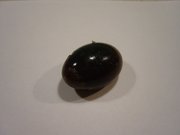Thousand-year egg
|
|
The thousand-year egg or century egg (Template:Zh-cp or Template:Zh-cp) is a Chinese delicacy made by preserving duck (or less commonly chicken) eggs in a mixture of charcoal and lime for (despite the name) only around 100 days. It is greenish in color, and has a creamy cheese-like flavor and strong aroma.
A common method of creating thousand-year eggs is to place the eggs in a mixture of clay and water; the clay hardens around the eggs, and is said to preserve them well for a considerable time. But another and much more elaborate method is also commonly practiced. An infusion of three pounds of tea is made in boiling water, and to this are added three pounds of quicklime (or seven pounds when the operation is performed in winter), nine pounds of sea-salt, and seven pounds of ashes of burnt oak finely powdered. This is all well mixed together into a smooth paste by means of a wooden spatula, and then each egg is covered with it by hand, gloves being worn to prevent the corrosive action of the lime on the hands. When the eggs are all covered with the mixture, they are rolled in a mass of straw ashes, and then placed in baskets with balls of rice - presumably boiled - to keep the eggs from touching each other. About 100 to 150 eggs are placed in one basket. In about three months the whole becomes hardened into a crust, and then the eggs are ready to eat.
According to a persistent myth, thousand-year eggs are or once were prepared by soaking eggs in horse urine. While theoretically a possible method of preparation — urea, like lime, is alkaline — this is not practiced today, and the myth may arise from ammonia smell created during some production processes.
A typical way of eating the preserved egg is with rice congee, as in lean pork and preserved egg rice congee (Template:Zh-cp). It is cut into quarters or eighths, and the seasoned marinated lean sliced pork is boiled with the eggs until the meat is cooked in the rice congee. Fried bread known as youtiao is commonly eaten with congee. The Cantonese wrap chunks of this egg with slices of pickled ginger root. It is also eaten alone as a side dish.
See also:
Centuryegg3.JPG


